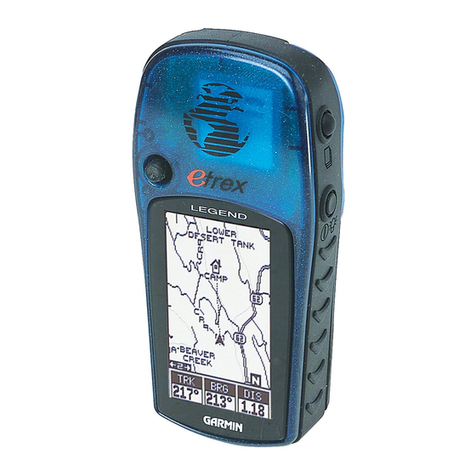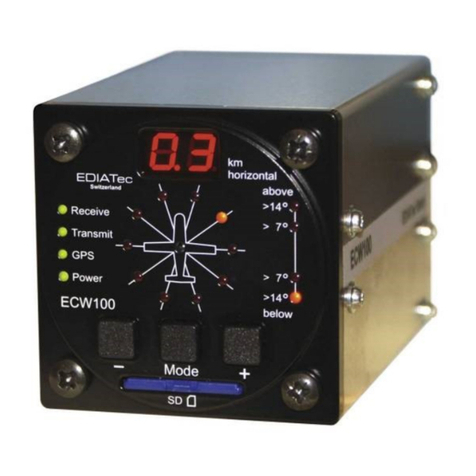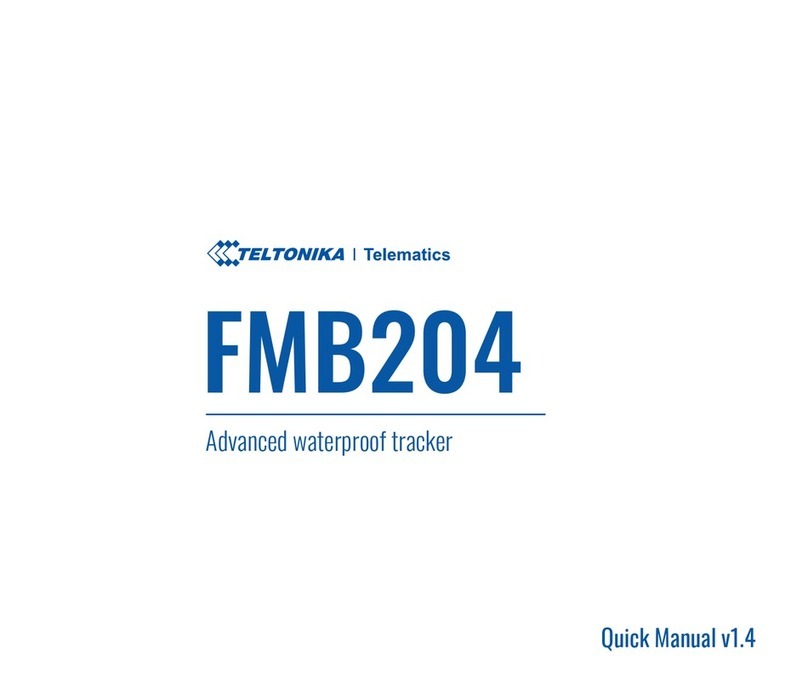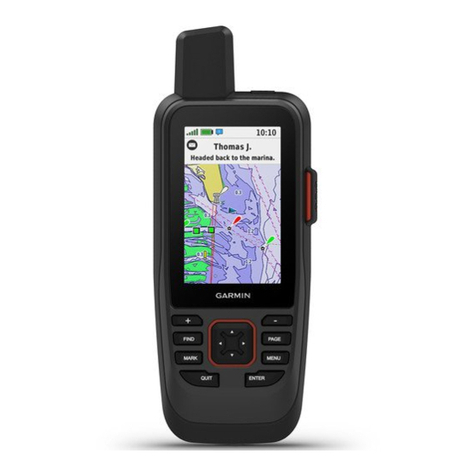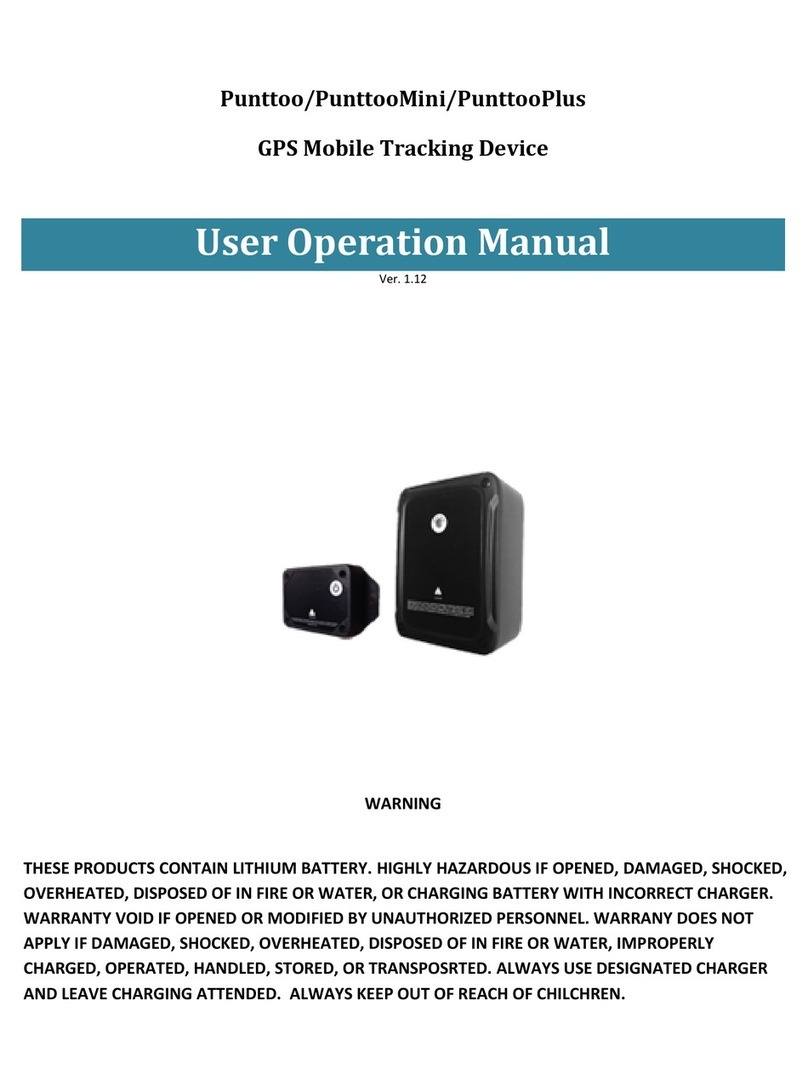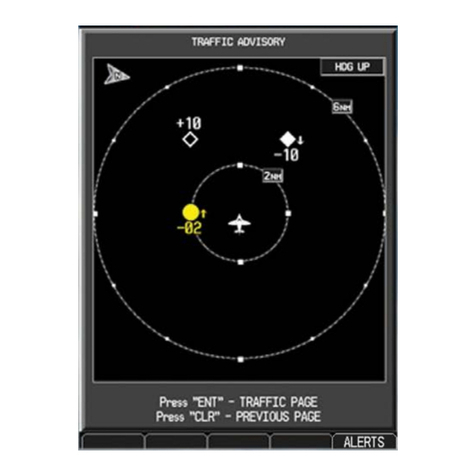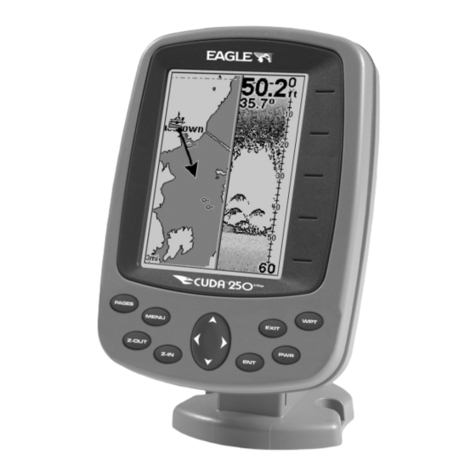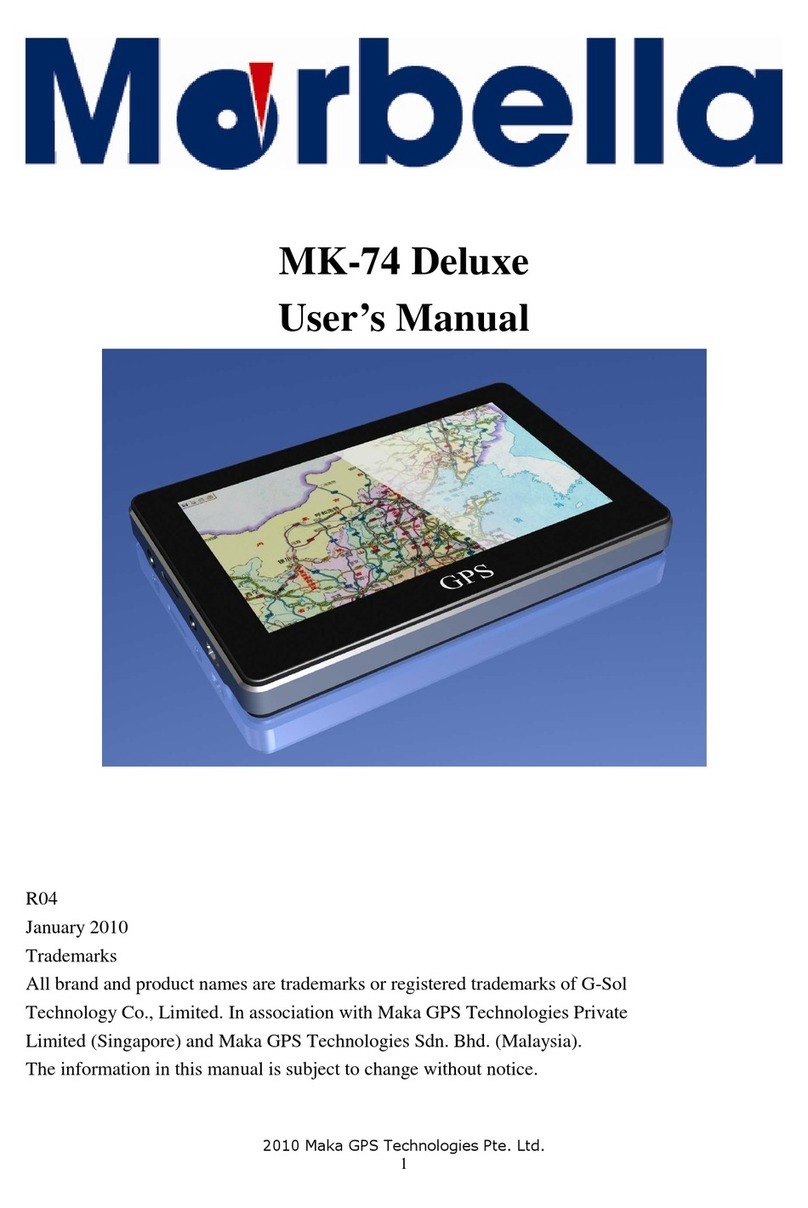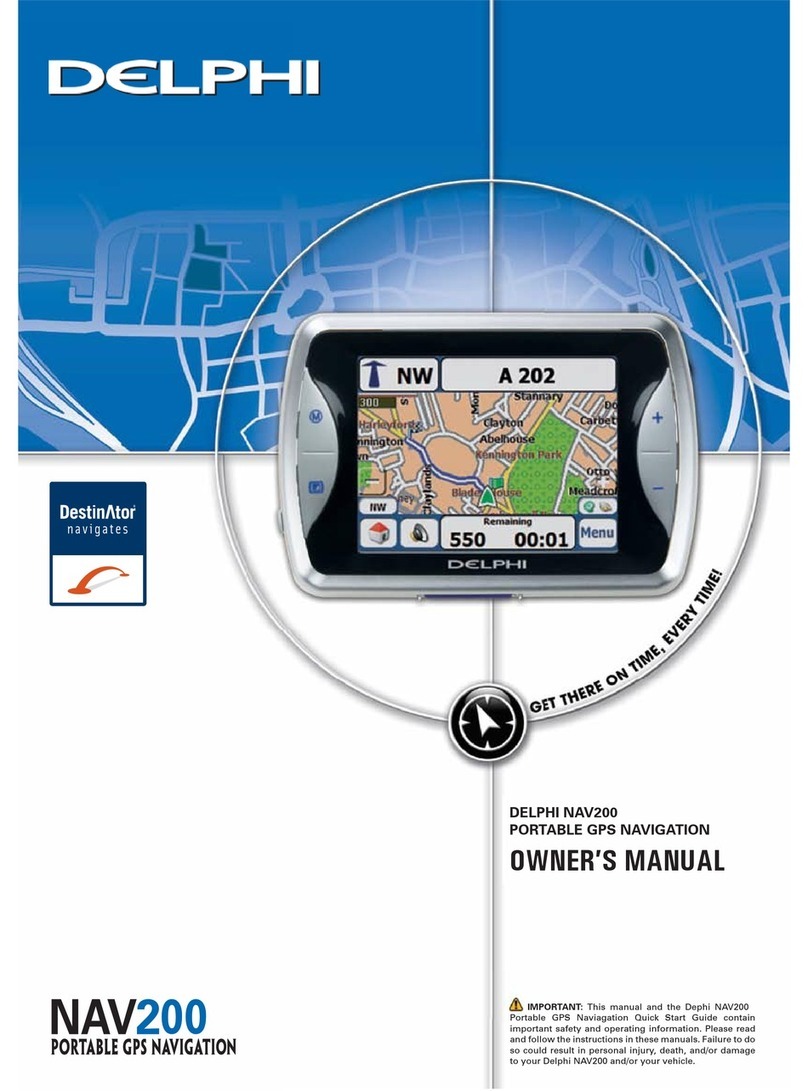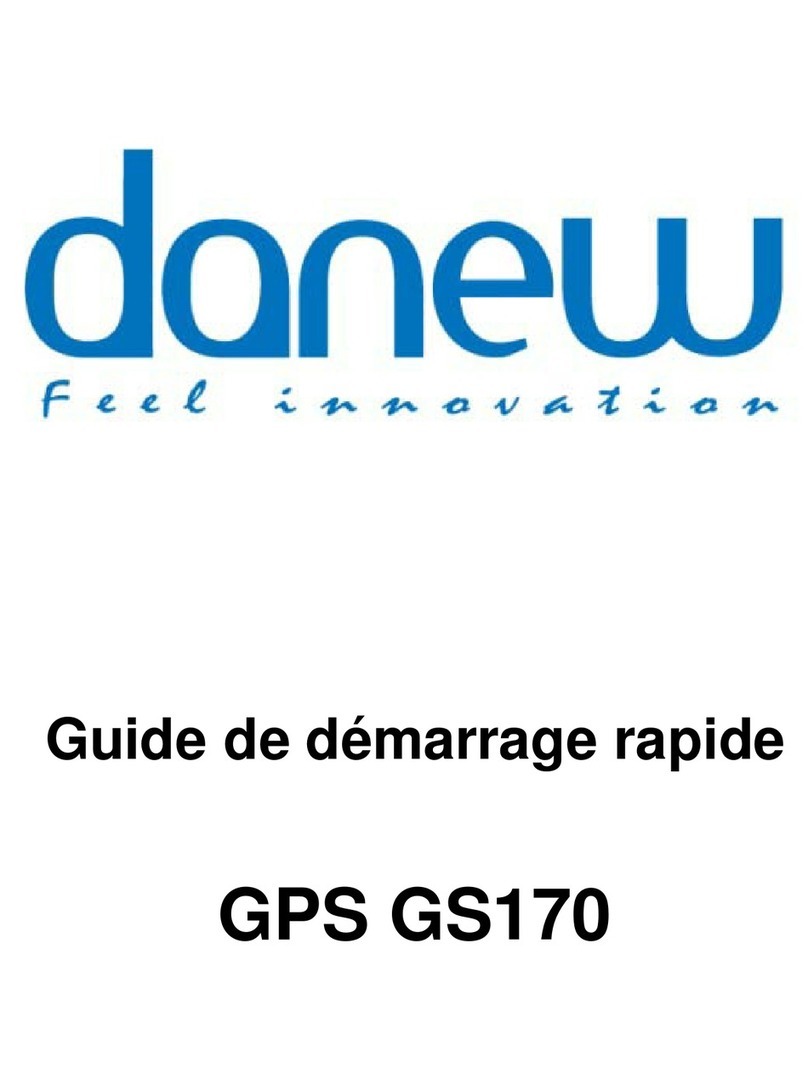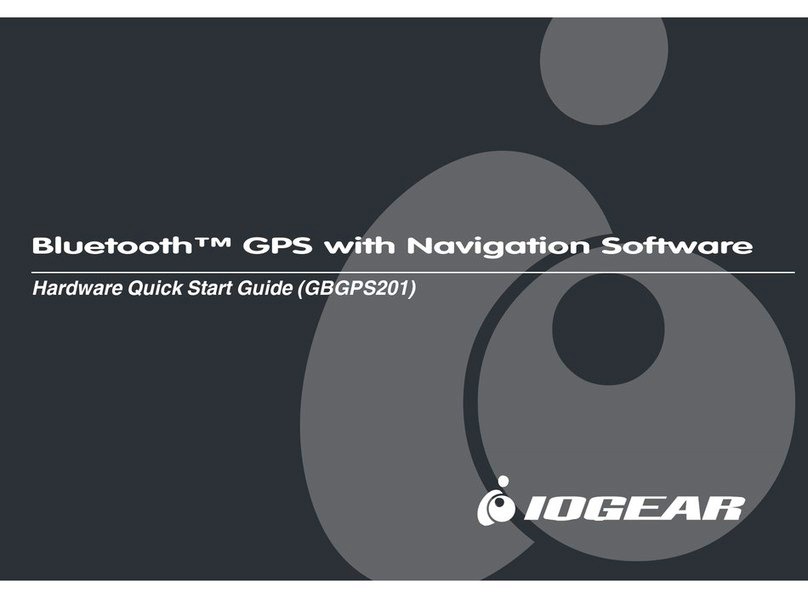BITREK BI 530R TREK User manual

Research and Production Enterprise "DISC SYSTEMS" LTD
EDRPOU 16303375, a/c No.260075014037759
at PJSC "UKREXIMBANK" in c. Kyiv
MFO 380333, TIN 163033726585
www.bitrek.com.ua
[email protected]om.ua
+380 44 507 02 07
03061, Ukraine, c. Kyiv, 95-S Otradny ave., Telephone +38044 507 02 07. Fax +38044 507 02 02. www.bitrek.com.ua, sales@bitrek.com.ua
Tracking device
for moving objects
BI 530R TREK
Operating manual
Version 2017.03.1

2
Content
Introduction.................................................................................................................................3
Safety requirements within installation and maintenance of "BI 530R TREK" tracking device..........3
Transportation and storage.................................................................................................................3
Warranty..............................................................................................................................................3
Device..........................................................................................................................................4
Purpose................................................................................................................................................4
Operation principles............................................................................................................................4
Technical specifications.......................................................................................................................5
Supply package....................................................................................................................................6
Preparation for operation, commissioning..................................................................................6
SIM-card installation ...........................................................................................................................6
Connectors for power supply and peripherals....................................................................................7
Assembly, commissioning ..........................................................................................................9
Assembly recommendations ...............................................................................................................9
Electrical connections..........................................................................................................................9
Device to computer connection..........................................................................................................9
Description of display bodies ............................................................................................................11
Adjustment of "BI 530R TREK" device...................................................................................11
Basic information...............................................................................................................................11
List of information commands to operate the device.......................................................................11
List of control commands to operate the device ..............................................................................14
Basic configuration ............................................................................................................................16
Security settings ................................................................................................................................16
Adjustment of I/O elements..............................................................................................................17
Notifications ......................................................................................................................................21
Roaming options................................................................................................................................21
Configuring the device to work with the RFID reader by RCS SOVA protocol on RS-485 bus ..........22
Configuring the device for working with fuel level sensors by RS-485 .............................................22
Appendix 1 - Device parameters...............................................................................................24
Appendix 2 - List of I/O elements.............................................................................................32

3
Introduction
Safety requirements within installation and maintenance
of "BI 530R TREK" tracking device
Technical staff involved in installation of tracking device is in charge
for compliance with security measures, as well as the staff responsible for
equipment at the work area.
Work area shall be in conformity with the fire safety regulations in
accordance with GOST 12.1.004 and electrical safety in accordance with
GOST 12.1.019.
Vehicles at the work area shall comply with the occupational safety
and health rules in accordance with the DNAOP (State regulations on labor
protection) 0.00-1.28-97.
To prevent damage, device shall be stored in a shock-proof
packaging. Before using, place the device so that you can see the indication
display elements. Before connecting/disconnecting the power socket and
inputs/outputs, turn off the power supply.
Transportation and storage
Transportation of tracking device in the transport packaging of the
manufacturer is allowed by all kinds of enclosed land and sea transport
(rail cars, containers, vehicles of closed type, bilges, etc.). Transportation
in pressurized heated compartments of the aircraft is allowed.
Transportation and storage shall be carried out under conditions in
compliance with storage conditions 3 according to GOST 15150-69.
Transportation and storage shall comply with requirements specified
by the signs on the packages.
Warranty
Warranty period of operation of tracking device is 12 months from
the date of sale of the device.
The warranty obligations of the manufacturer are valid if the
consumer observes the requirements of this manual. In case of their
violation, or at any mechanical or electrical damages caused by factors
other than specified by this manual, the warranty shall be considered null
and void.

4
Device
Purpose
Tracking device "BI 530R TREK" shall be applied to solve issues of
navigation, remote control and monitoring of a vehicle or other remote
object.
The tracking device is designed to be installed on any mobile or
remote stationary object in order to:
determine the geographical coordinates, speed and direction
of movement;
ensure data collection from external devices;
control actuating mechanisms;
transmit data to the control dispatching center.
Data communication channel is the network of mobile
communication operator with GSM standard 900/1800. LBS, GPS or LBS,
GPS/GLONASS are used to determine the coordinates.
Device shall be installed out of reach of the driver.
The device is not designed to run on water transport.
Operation principles
In real time mode the tracking device:
determines location and movement parameters of the object
(time, geographical coordinates, speed, and direction).
collects and processes information from the analog, digital, and
discrete sensors
ensures control over actuating mechanisms upon command
from the control dispatching panel.
Received data are recorded and stored in an internal log, which is
implemented on microchip of nonvolatile memory. At specified intervals or
according to event entries from this log are sent to the server of the
dispatcher via the GSM network. Exchange of information is carried out by
means of GPRS and SMS channels.
Operation of the device in "on-line" mode is possible only at presence
of the network coverage of cellular transmission by GSM 900/1800
standard. Outside GSM network coverage, the tracking unit operates in the
"black box" mode, i.e., it records all information in the nonvolatile memory
and sends it when the vehicle is entering a GSM coverage area.

5
Technical specifications
Table 1 - Technical specifications
N
o.
Name
Technical
specification
1
Data transmission standard
GSM 900/1800
2
GSM network communication channel
GPRS, SMS
3
SIM-cards quantity
1
4
SIM-card format
Micro-SIM
5
GPRS class
10
6
Type of navigation system
LBS, GPS or LBS,
GPS/GLONASS
7
GSM and GPS antennas
Internal
8
Auxiliary digital interfaces
RS-485
9
Motion sensor
Accelerometer
10
Number of discrete inputs with active
"0"
1
11
Number of discrete inputs with active
"1"
2
12
Number of discrete outputs
2
13
Type of power supply
Direct current
14
Accumulator battery capacity
130 mAh
15
Supply voltage
From 6 V to 36 V
16
Average consumption current (12 V)
60 mA
17
Range of voltages of discrete inputs
From 0 V to 40 V
18
Type of discrete outputs
Open collector
19
Maximum current of discrete outputs
0.5 А
20
Number of analog inputs
2
21
Range of voltage of analog inputs
From 0 V to 27 V
22
Volume of nonvolatile memory
2 MB (or 50 000
records)
23
Operating temperature
From -30 °C to +80 °C
24
Relative humidity of air
(80±15) %
25
Dimensions (L x W x H)
(96 x 77 x 14) mm
26
Weight of the device
75 g
27
Housing protection class
IP54
28
Housing material
Plastic ABS UL94V0

6
Design of tracking device
Appearance and dimensions of the tracking device "BI 530R TREK" are
shown in Figure 1.
Figure 1 - Appearance and design of the device.
Supply package
The tracking device "BI 530R TREK" is provided with the following set:
1. Tracking device "BI 530R TREK" - 1 piece.
2. Connection cable - 1 piece.
3. Technical data sheet - 1 piece.
4. Warranty card - 1 piece.
Preparation for operation, commissioning
SIM-card installation
To operate in GSM network device shall contain installed SIM-card of Micro-
SIM format. Phone book of SIM-card shall remain empty, PIN-code shall
be removed (use of SIM-card with PIN-code can be allowed subject to
entering the PIN-code to the device settings).
To install the SIM-card disconnect the power socket from the device,
remove the side cover and install the SIM-card into the slot (see Figure 2).

7
Figure 2 - Installation of SIM-card into the device.
Connectors for power supply and peripherals
The rear panel of the tracking device contains sockets for connecting
cables. Connecting cables in turn have outlets for power, analog, digital,
discrete sensors and actuating mechanisms. Location of sockets and
numbering of contacts are shown in Figure 3.
Marking of connector pins for power supply, sensors and peripherals
is shown in Table 2.

8
Figure 3 - Location of sockets and numbering of contact elements.
Table 2 - Designation of contact elements
No.
Colour
Name of
contact
Type of
signal
Contact element
assignment
1
Black
GND
Power
supply
Common wire (ground)
2
Brown
DAT low
Input
Discrete input with active
"0" (1-20 kHz frequency
input, pulse counter)
3
Black
GND
Power
supply
Common wire (ground)
4
White
AN in 1
Input
Analog input No. 1
5
Violet
Out 1
Output
Discrete output No. 1
6
Orange
RS-485 A
Input/outp
ut
Data signal interface RS-
485
7
Black
GND
Power
supply
Common wire (ground)
8
Red
+ V in
Power
supply
"+" of on-board power
supply (rated voltage of
12 V or 24 V)
9
Blue
DAThigh 1
Input
Discrete input with active
"1" No. 1
10
Yellow
DAThigh 2
Input
Discrete input with active
"1" No. 2
11
Grey
AN in 2
Input
Analog input No. 2
12
Pink
Out 2
Output
Discrete output No. 2
13
Green
RS-485 B
Input/outp
ut
Data signal interface RS-
485
14
Black
GND
Power
supply
Common wire (ground)

9
Assembly, commissioning
Assembly recommendations
Zone of installation of tracking device shall enable the connecting of
the pin to it and disable the possibility of accidental damage to the device,
moisture, impact of high temperature. Recommended location for
installation in the vehicle is an empty space under the dashboard inside
the vehicle; in addition, the device shall be placed in a way ensuring the
upper side with LEDs to face up.
The body of the device contains grooves for easy fastening with
plastic ties.
Electrical connections
Power supply wires are laid through the maintenance holes in the
body of the vehicle from the regular battery location to the place of
installation of the tracking device. Power wires are connected to the
corresponding battery terminals.
Carrying out welding work during the repair of the vehicle
necessarily requires disabling of power socket and peripherals.
The active state for discrete input with active "0" is a connection of
this input with the negative of the power (ground). The passive state for
this input is the lack of connection ("in the air" input).
The active state for the discrete inputs with active "1" is to supply to
these inputs the voltage exceeding + 8 V. The passive state for these
inputs is the lack of connection ("in the air" input).
Analog input voltage can range from 0 V to 27 V.
The discrete outputs of the device are made according to the scheme
such as "Open collector". The load shall be connected to the gap between
the discrete output and "+" power of the on-board network. When
activated, the output gets ground switching. Maximum current of the
discrete output load shall not exceed 0.5 A. If it is needed to switch higher
currents, connect digital outputs via additional relay.
The voltage on the discrete inputs shall not exceed 40 V.
The voltage on the analog inputs shall not exceed 27 V.
The power supply voltage of the device shall not exceed 36 V.
Otherwise, the device may be disabled.
Device to computer connection
The tracking device can be connected to a PC, in order to configure
the device, as well as to perform maintenance works. For this purpose, the
device is equipped with a service UART output. To connect to a computer,

10
use an additional USB-UART converter, which can be purchased from a
dealer for an additional fee.
UART service output socket is located on the board of the device next
to the SIM-card slot. To access the socket, remove the side cover of the
device. Procedure of connection of USB-UART converter cable is shown in
Figure 4.
Connect the cable of USB-UART converter to the tracking device so
that the arrow on the cable socket to be located closer to the SIM-card slot
(see Figure 4).
To work with the USB-UART converter, install the appropriate device
drivers. They can be downloaded from the official website:
http://www.ftdichip.com
To exchange data with the device, use a terminal program. Settings
of the terminal: speed - 115200 bit/second, data bit - 8, stop bit - 1, no
parity check, no flow control.
Figure 4 - Connection of the cable of USB-UART converter to the
device "BI 530R TREK".
Once connected, the device will transmit data about its state to the
terminal. In addition, the user is able to use a terminal program to send
commands to a device and receive response to them. Send preliminary to
device the password to access the terminal in the following format:
TPASS: password;
, where password is a password for access to the device terminal (default
value is 11111).
Lifetime of access password after sending is 60 seconds.
After this time, re-send the password to exchange data with the device.

11
Description of display bodies
Top panel of the tracking device contains two LEDs that indicate the
current status of the device.
LED "STATUS" (red) is on for 0.5 seconds and is off for 0.5 seconds
when GPRS connection is inactive; is constantly on when GPRS connection
is active and the device is connected to a remote server; LED slowly flashes
for 0.2 seconds when GPRS connection is not active, and the modem is in
sleep mode.
LED "GNSS" (green) flashes (or lights) when the device is receiving
correct position coordinates and is off when the device is not receiving the
coordinates, or the signal is too weak, and the data are not correct.
Adjustment of "BI 530R TREK" device
Basic information
The tracking device "BI 530R TREK" can be configured in following
ways:
1. With a direct connection of the device to a computer.
2. Remotely, using SMS commands.
3. Remotely, using the configuration server.
Setting of the device through any of the available methods is limited
with the setting of the required values of the device parameters. Each
parameter has its own unique ID. Special commands are used to
read/record the values of selected parameter.
At remote configuration via SMS take into consideration that the total
length of the SMS shall not exceed 160 Latin characters. Number of
commands in SMS is limited to a maximum length of SMS.
All commands for the device are divided into control and information
commands.
List of information commands to operate the device
Table 3 - List of information commands to operate the device "BI 530R
TREK"
N
o.
Comman
d
Description
Availabil
ity of
respons
e
1
getstatus
Information about current state of the
device
yes
2
getgps
Current GPS coordinates and time of
device.
yes
3
getmap
Request of device coordinates
yes
4
getver
Request of the version of the device
software
yes

12
5
getio
Read the value of the device's internal
sensors
yes
6
flush
Request of device profile parameters
yes
7
getparam
####
Read the value of the parameter by its ID
yes
Notes to Table 3.
Information about current state of the device
Command to be send - getstatus;
Example of response:
«Data Link: 1 GPRS: 1 IP: xxx.xxx.xxx.xxx GSM: 4 Roaming: 0»
, where:
Data link –current connection status (0 - not connected to the server, 1 -
connected to the server);
GPRS - status GPRS (0 - not active, 1 - active);
IP –IP address of the device. With an active GPRS connection it is assigned
by the operator (not to be confused with the IP address of the server);
GSM - level of GSM signal (1 - minimum, 5 - maximum);
Roaming - SIM-card in roaming (0 - home network, 1 - roaming).
Current GPS coordinates and time of device.
Command to be send - getgps;
Example of response:
"GPS: 1 Sat: 7 Lat: 50.2345 Long: 30.1652 Alt: 123 Speed: 0, Dir: 77
Date: 2016/2/15 Time: 14:37:32"
, where:
GPS –status of GPS data (1–valid, 0 –invalid);
Sat –number of satellites visible for the device;
Lat - latitude (last known latitude);
Long - longitude (last known longitude);
Alt - altitude, height above sea level;
Speed - speed (km/hour);
Dir - direction of motion (degrees);
Date –current date (1980/1/6 is transmitted in the absence of GPS-
signal);
Time –current GMT time (in the absence of a GPS signal there is
transmitted 00:00:00).
Request of device coordinates.
Command to be send - getmap;
Example of response:
«www.biakom.com/maps/q=50.420209,30.428448,12,0»

13
Request of the version of the device software
Command to be send - getver;
Example of response:
«BI-520R Ver: 3.92»
Read the values of the device's sensors.
Command to be send - getio;
Example of response:
«DL1: 1 DH1: 0 DH2: 0 DO1: 0 DO2: 0 VPSV: 12996mV VBAT: 4290mV
AIN1: 37mV AIN2: 38mV»
, where:
DL1: 1 DH1: 0 DH2: 0 - current state of the discrete inputs;
DO1: 0 DO2: 0 - current state of the discrete outputs;
VPSV - external power supply, millivolts;
VBAT –power supply of device accumulator battery, millivolts;
AIN1: 37mV AIN2: 38mV - analog inputs voltage, millivolts.
Request of device profile parameters.
Command to be send - flush;
Example of response:
«xxxxxxxxxxxxxxx, gps.utel.ua, none, none, xxx.xxx.xxx.xxx, xxxxx 0»
, where:
IMEI (xxxxxxxxxxxxxxx) - identification number (IMEI) of the device;
APN (gps.utel.ua) –access point for GPRS connection (to be specified by
the operator);
Login (none) –access login to GPRS (to be specified by the operator,
usually, it is not required);
Password (none) –access password to GPRS (to be specified by the
operator, usually, it is not required);
IP (xxx.xxx.xxx.xxx) –Server IP address for data transmission;
PORT (xxxxx) - PORT of server for data transmission;
MODE (0) - mode of device operation (0 - TCP/IP connection).
Read the value of the parameter by its ID
Command to be send - getparam ####;
Parameter ID (####) consists of four digits and indicates the number of
the parameter. All configurable parameters are specified in the list of
device parameters (see Appendix 1 and Appendix 2).
Example of response:
«Param ID #### Val: #»
, where:
Param ID –ID of requested parameters;
Val –current value of parameter.

14
Example of the command to request APN of the device (a parameter that
contains the APN device has ID 0242) - getparam 0242;
Example of response:
«Param ID 0242 Val: gps.utel.ua».
List of control commands to operate the device
Table 4 - List of control commands to operate the device
No.
Command
Description
Availability
of
response
1
cpureset
Reload of device processor
no
2
rstallprof
Restoring of original state of profile
settings
no
3
deleterecords
Deletion of all saved records
no
4
setparam
####
Set the value of the parameter by ID
yes
5
boot #,#,#
Update of device software
yes
6
setdigout ##
Set the mode of operation of digital
outputs Out 1 and Out 2.
yes
7
ignitionoff
Activation of the safety locking of
ignition
yes
8
ignitionon
Deactivation of the safety locking of
ignition
yes
Notes to Table 4.
Reload of device processor.
Command to be send - cpureset;
No response is returned for this command. Receipt of the command
initiates a complete restart of all device processes.
Restoring of original state of profile settings.
Command to be send - rstallprof;
No response is returned for this command. Receipt of this command
initiates reset of profile parameters to default ones.
Deletion of all saved records.
Command to be send - deleterecords;
No response is returned for this command. Receipt of the command deletes
all the data packets from the device memory.
Set the value of the parameter by ID
Command to be send - setparam ####;
Parameter ID (####) consists of four digits and indicates the number of
the parameter. All configurable parameters are specified in the list of
device parameters (see Appendix 1 and Appendix 2).

15
Example of response:
«Param ID #### New Val: #»
, where:
Param ID –ID of parameter to be set up;
New Val –assigned value of parameter.
Example of the command to set APN of the device (a parameter that
contains the APN device has ID 0242) - setparam 0242 gps.utel.ua;
Example of response:
"Param ID 0242 New Val: gps.utel.ua».
Update of device software.
Command to be send - BOOT #,#,#;
Example of command to update the software:
«BOOT biakom.com,80,pr/*.bin;»
, where:
«HOST» - (biakom.com,) is address of server locating the update files;
«PORT» –(80,) - port of server locating the update files;
«PATH» - (pr/) –location of update files on server;
«Firmware» - (*.bin;) –binary update file,
where * is the firmware version, .bin is the file
extension.
This command allows remote software update of the device via GPRS
channel.
Note: Enable "download" for the SIM-card, and set the session timeout not
less than 10 seconds.
There are following responses at attempt to update the device software:
«BOOT: UPDATE DOWNLOAD OK»- successful update;
«BOOT: WAITE ERROR» – exceeded timeout at downloading software
update;
«BOOT: HOST CONNECT ERROR» –failure to connect to SW server;
«BOOT: PAGE LOAD ERROR» –failure to load the file;
«BOOT: UPDATE DOWNLOAD ERROR» –failure to update the file.
Set the mode of operation of digital inputs Out 1 and Out 2.
Command to be send - setdigout ##;
Example of command for the activation of the output Out 1: setdigout 10;
Example of command for the activation of the output Out 2: setdigout 01;
The first digit in the command is Out 1 output state, the second digit is Out
2 output state.
When it is necessary to activate the output, set the output value must to
"1". When it is necessary to deactivate the output, set the value to "0".

16
Activate/deactivate the safety locking of ignition.
Command to activate safe locking –ignitionon;
Command to deactivate safe locking –ignitionoff;
In case of activation of secure locking the discrete output Out 1 will be
activated if the speed according to GPS is less than 5 km/h.
Examples of response:
«Set RQS To Ignition On» - ignition switch on;
«Set RQS To Ignition Off» - ignition switch off;
Basic configuration
After installing the SIM-card of the mobile operator and connection of the
power supply, the device shall be configured to transmit data to the server.
All adjustable parameters of the device are divided into groups:
Server and GPRS.
Tracking.
Security.
Service.
Voice communication.
Roaming.
Setting required for basic operation of the device include data
transmission and tracking. They are grouped in "Server and GPRS" and
"Tracking". After setting up the necessary parameters the device will
transmit data about its current location to the server.
All parameters available for configuration are specified in Appendix
1.
Security settings
To meet the safety conditions, access to the configuration of the
device can be limited.
At connection your device to the PC using USB-UART converter,
every time you send a command, the device requires the access password.
Standard access code is 11111. Lifetime of password is 60 seconds. After
this timeout the password shall be re-entered. Access password can be
changed by the user (ID 0910, see Appendix 1).
Format of sending a standard password to the device is TPASS:
11111;
Examples of response:
«TASK COM TERM: PASSWORD OK» –correct password is entered;
«TASK COM TERM: INCORRECT PASSWORD» –incorrect password is
entered;
When sending commands via SMS, set the login and password of
SMS access. To set the login use ID 0252 parameter, to set the password
use ID 0253.

17
To set the login and password, any SMS command shall have the
following structure to be sent:
<Login><Password><Command1>;<Command2>;<Command3>;
Example of the command to be sent: abcd 1234 getgps; getstatus;
In addition to the login and password, use the authorized phone
numbers. To record the telephone numbers in the memory device use the
parameters ID 0261 - ID 0269 (Appendix 1). Total up to 8 phone numbers
can be applied. When using this function, the device will respond to SMS
from the stored in the memory authorized phone numbers only.
If the login and password are set by SMS, they shall be specified in
each SMS with commands.
Adjustment of I/O elements
The tracking device "BI 530R TREK" is able to collect, process and
send to the server the data received from various sensors. Each sensor is
an I/O element and has a group consisting of 6 parameters for setting. For
example, to set the value of power supply voltage level to the server, use
group of parameters of ID 0410/0411/0412/0413/0414/0415. These
options have the following structure:
0410/0411/0412/0413/0414/0415
First 3 numbers (green) refer to parameter group number to
configure the I/O element.
Last number (grey) is a parameter number.
6 parameters (from 0 to 5) are available for a single I/O element. Possible
values of these parameters are presented in Table 5.
Table 5 - List of parameters of I/O elements
Parameter
number
Description
Possible values
0
Enable/disable I/O
element
0 - disabled; 1 - enabled
1
Priority of I/O
element at
transmission
0 - low; 1 - high
2
Upper limit
(depending on the type of I/O
element)
3
Lower limit
(depending on the type of I/O
element)
4
Setting of the type of
the generated event
0 - entering the range;
1 - leaving the range;
2 - returning/leaving to/of the
range;
3 - monitoring;

18
4 - monitoring + entering the
range;
5 - monitoring + leaving the range;
6 - monitoring + return to/leaving
the range;
7 - generation of the event to
change the input value to a
predetermined value;
8 - generation of the event to
change the input value to a
predetermined value + monitoring
5
Averaging constant
From 0 and higher
Notes to Table 5:
Parameter 0 - on/off of transmission of I/O element to the server.
Parameter 1 - Priority: low/high. While selecting "Priority:
low" - data of the sensor will be sent to the server with the following data
packet. While selecting "Priority: high" data of the sensor will be sent to
the server at the earliest possible opportunity.
Parameter 2 - Upper limit - set the upper limit of the I/O element.
Parameter 3 - Lower limit - set the lower limit of the I/O element.
Parameter 4 - Set the type of the generated event:
0 - Returning to the range.
At a specific range of sensor values (range of values is specified as
follows - lower limit of the range is recorded to the corresponding
parameter - "Lower limit", upper limit of the range is recorded to the
corresponding parameter "Upper limit"), the event will be generated
when the actual value of the sensor gets within the specified range.
In other cases, the event will not be created and the information will
not be sent to the server.
Example: The lower voltage limit is set to 0, the upper limit is set to
10 V (10 000 mV). Lowering the voltage below 10 V will generate
the event (see Figure 5).

19
Figure 5 - Generation of event by returning to the range.
1 - Leaving the range.
The event will be generated if the actual sensor value is outside the
predetermined range.
Example: The lower voltage limit is set to 0, the upper limit is set to
10 V (10 000 mV). Rising of the voltage above 10 V will generate the
event (see Figure 6).
Figure 6 - Generation of event by leaving the range.
2 - Returning/leaving to/of the range.
Event is generated every time when the actual value of the sensor is
out of the limits of the predetermined range.
Example: The lower voltage limit is set to 5 V (5 000 mV), the upper
limit is set to 10 V (10 000 mV). When the actual voltage crosses
limits of the specified range, then event is generated (see Figure 7).

20
Figure 7 - Generation of event by returning/leaving to/of the range.
3 - Monitoring.
When this mode is selected, data will be transmitted continuously,
the events will not be generated.
4 - Monitoring + entering the range.
When there is generated the event after entering the range, the
actual value of the sensor starts to be transmitted to the server in
the monitoring mode.
5 - Monitoring + leaving the range.
When there is generated the event after leaving the range, the actual
value of the sensor starts to be transmitted to the server in the
monitoring mode.
6 - Monitoring + returning/leaving to/of the range.
When one of the events is generated, the actual value of the sensor
starts to be transmitted to the server.
7 - Change of the input value to a predetermined value.
Changing of the input value to the predetermined value in either
direction will cause the event generation. The value is recorded to
the parameter "Upper limit".
8 - Monitoring + change of the input value to a predetermined value.
When the event is generated, the actual value of the sensor starts to
be transmitted to the server.
Parameter 5 - Averaging constant.
It is time required for I/O to be in a certain state in order to generate
an event. It is measured in milliseconds (X*50 ms, i.e., while setting 10,
the constant will be equal to 10*50=500 ms).
List of all I/O components of the device, available for configuration,
is provided Appendix 2.
Table of contents
Other BITREK GPS manuals
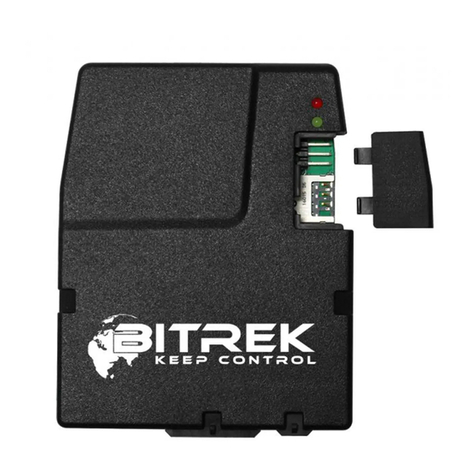
BITREK
BITREK BI-530C TREK User manual

BITREK
BITREK BI-910 TREK User manual
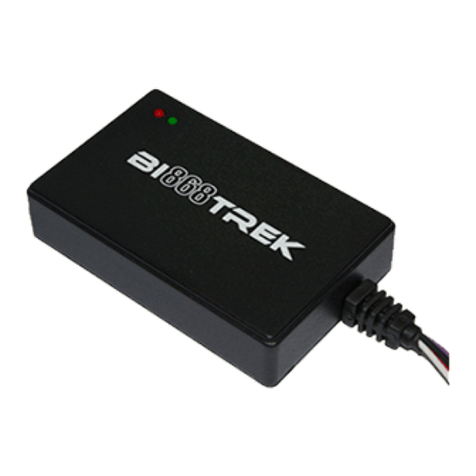
BITREK
BITREK BI 868 TREK User manual
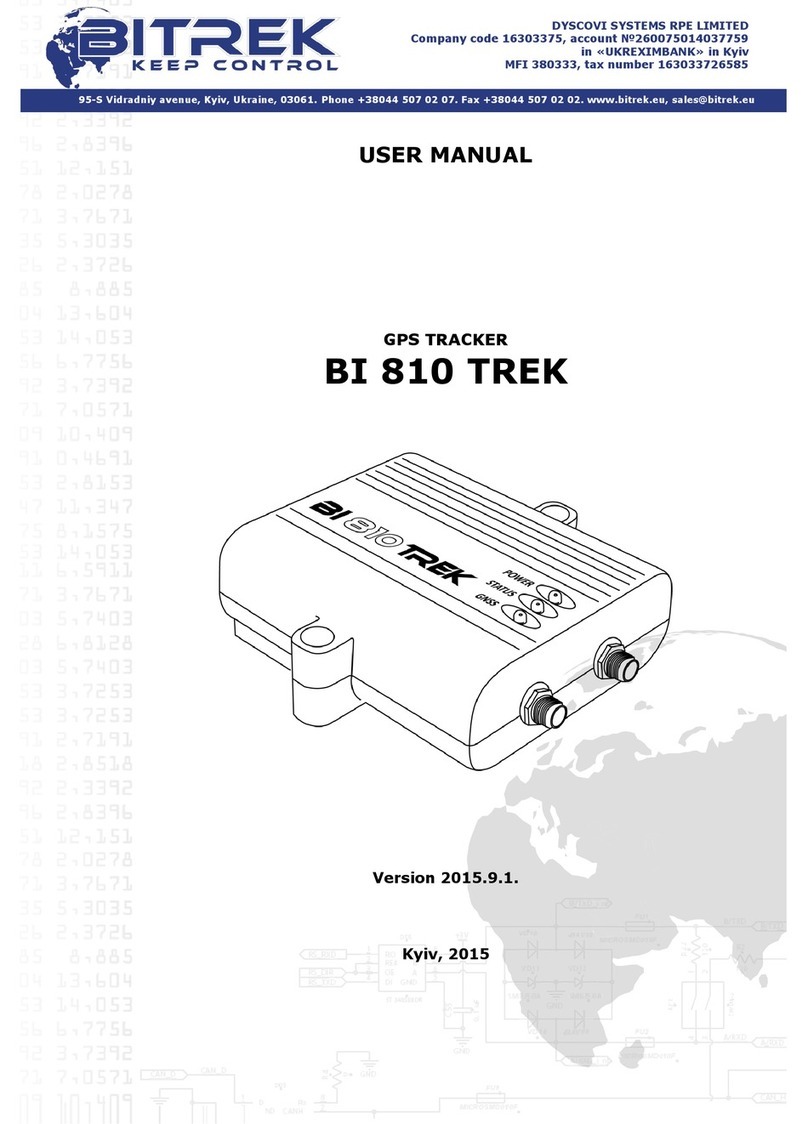
BITREK
BITREK BI 810 TREK User manual
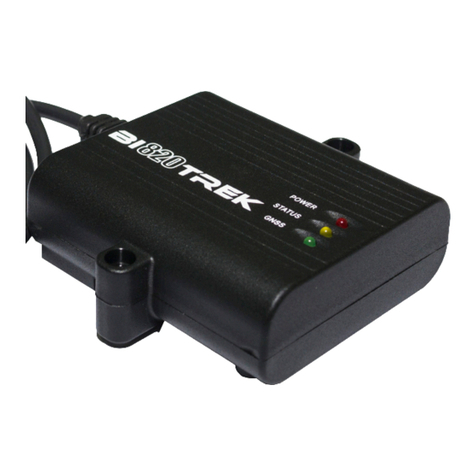
BITREK
BITREK BI-820OBD TREK User manual
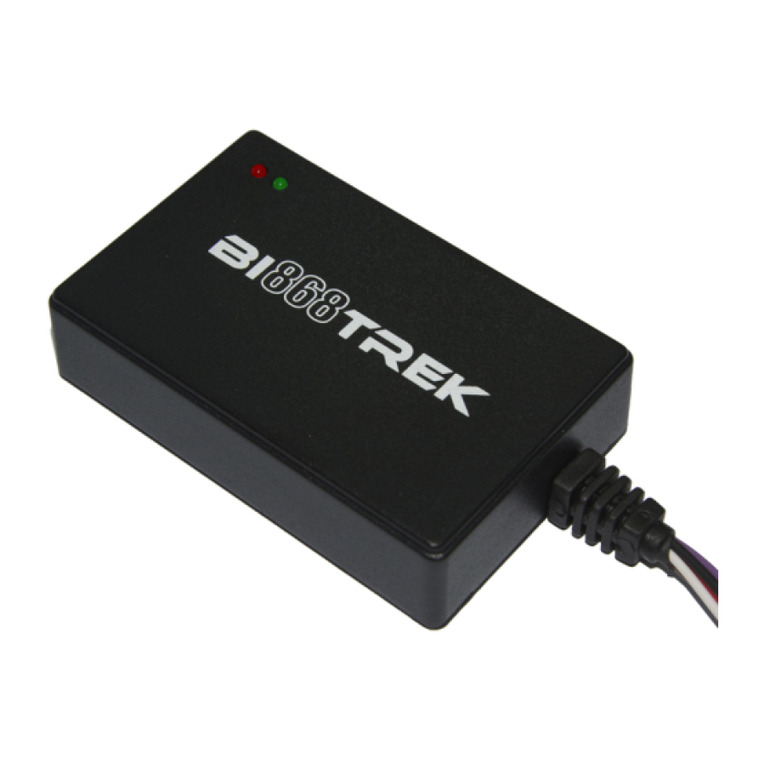
BITREK
BITREK BI-868 TREK HW2 User manual
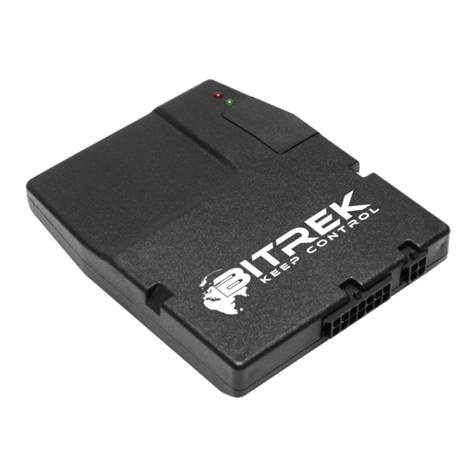
BITREK
BITREK BI-530P TREK User manual

BITREK
BITREK BI-520L TREK User manual

BITREK
BITREK BI-810 TREK User manual
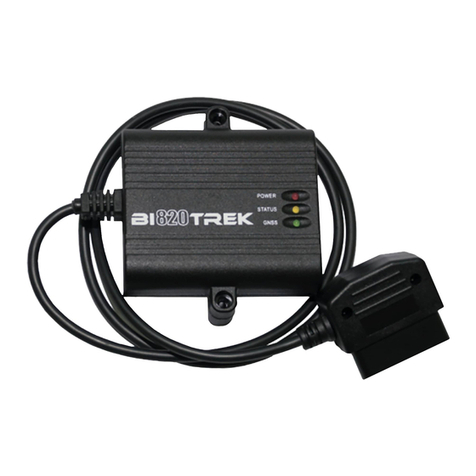
BITREK
BITREK BI 820 TREK OBD User manual

